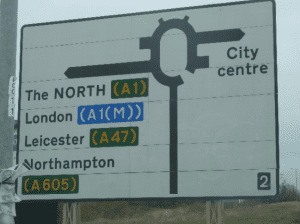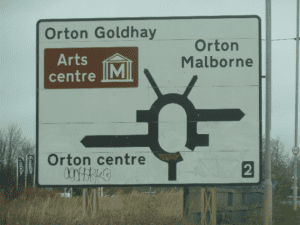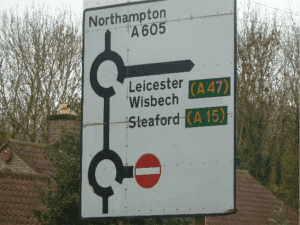On our Intensive Driving Course in Peterborough (01733 306016), our pupils will come across literally dozens of roundabouts of varying size and shape. One of the main reasons why some people struggle to deal with roundabouts effectively is because they are unable to imagine, visualise in their head what is going to happen as they approach the roundabout. This blog will introduce the importance of taking note of what roundabout signs actually tell us as drivers.
 Take a look at the following roundabout sign. Whilst you are very likely to come across these on your Intensive Driving Course in Peterborough, they most certainly will not be covered on any driving test. Imagine you have passed your test, and you see these two signs:
Take a look at the following roundabout sign. Whilst you are very likely to come across these on your Intensive Driving Course in Peterborough, they most certainly will not be covered on any driving test. Imagine you have passed your test, and you see these two signs:
 Now take a look at this roundabout sign.
Now take a look at this roundabout sign.
Let’s just take a minute to actually notice the information that is on those signs, because although this might come as a surprise, these 2 signs are on the same approach of the same roundabout in Peterborough.
- The top sign has the roundabout placed higher up on the sign, so that it enables all the destinations to be listed down the left hand side
- The top sign has no destinations listed for the exits at the top of the sign. When you see 2 roundabout signs on approach to the same roundabout, the first one will have major destinations listed eg London, Northampton, the second one will have local destinations listed. As such, there is seldom any repeating of destinations between the 2 signs. On some roads, the background colour of the roundabout signs differ depending on which type of destinations they have listed. You will see plenty of examples on your intensive driving course in Peterborough of the first, major destinations roundabout sign being green, and the more local destinations roundabout sign that comes after having a white background colour.
- The actual round, roundabout symbol is not a full circle. This is intended to reflect the fact that you can’t drive right as you come on to the roundabout. Remember there are many non-UK drivers on our roads, and some might need reminding which way they travel round a roundabout.
- The number 2 in the corner relates to the junction number on the dual-carraigeway, and these junction numbers can be seen on maps and sat navs.
- You will be approaching this roundabout from the 6 o/c position (on a clock face). Don’t assume this is always the case, whilst it often is, pay attention to where the broken link is, as that is an indication of the position you are approaching the roundabout at. There is an example in Peterborough where the sign indicates that you are approaching the roundabout at the 3 o/c position, not the traditional 6 o/c position – again, don’t worry, you will have plenty of opportunity to see all of this on your intensive driving course in Peterborough.
- The long wide black lines with arrow heads at the end are exits off of the roundabout, the shorter, stubby black lines with no arrow heads are entry points on to the roundabout. If you see thin black lines with no arrow heads, it can be because the exit leads to a dead end, it can also be that the exit is for a destination that is not intended to be shown on that particular roundabout sign eg the top roundabout sign has short black lines at 11 o/c and 1 o/c as the exits are for local destinations and not intended for that sign.
- Notice the different colours denoting different class of roads and local places of interest/tourist attractions
- Notice that if you were unfamiliar with this roundabout, you would have no idea how many exit lanes there are for each of the exits shown.
 Now take a look at this roundabout sign in Peterborough:
Now take a look at this roundabout sign in Peterborough:
There a couple of things to note about this sign:
- The sign is showing that the 2 roundabouts (in this case mini-roundabouts), are very close together. No sooner have you exited the first roundabout when you are then approaching the second roundabout. This can be quite an important point, because as is the case in this example, if driving to Leicester, you would do well to approach the first roundabout in the right hand lane, so that you exit it in the right hand lane and approach the second in the right hand lane. Fail to do get in the correct lane on the approach to the first, and you will have some awkward manoeuvring to do between the two roundabouts which in real terms is no more than 20 metres of distance.
- Notice the roundabout at the bottom actually only has 2 exits available as you approach it. Either straight over, first exit, or all the way round and going back the way you come (a manoeuvre that the Highway Code advises you try to avoid on mini-roundabouts as it can surprise other road users). You see the short stubby black line at 3 o/c has a no entry sign, that is because it is an entry to the roundabout, not an exit. This is the same point made in the first example, except in this case, they have included a “no entry” sign to emphasise the fact that you must not drive in to that entry point. I have actually seen an elderly male driver do precisely that, thankfully, without causing an accident on that occasion. Check out my weekly motoring news blog HERE where you might be very surprised to see what some drivers do actually do. You will see for example an elderly lady recently drove on to a 2 laned dual carriageway in Peterborough and immediately turned right against the flow of traffic. It was sadly the last mistake she made in her life, as she died in the collision that followed and hospitalised a lady driver in her 40’s from Werrington.
I hope this blog has helped to explain the importance of spotting roundabout signs on the approach, and giving yourself enough time on the approach to identify which number exit you will be needing, so that you can then visualise how it will be going as you drive round. Remember that whilst I am referring to roundabouts in Peterborough here as this a blog to help my customers on my Intensive Driving Courses in Peterborough, the real aim is for you to be able to decode these roundabout signs anywhere in the country. With that in mind, check out this video here from my popular YouTube driving channel HERE. This video is good because it’s a quiz for you to have a go at, and is using a handful of real roundabout examples in Peterborough, Spalding and Grantham. It is encouraging you to not only think about effectively reading roundabout signs but also mentions about lane markings and indicator signals.
BIG TOM Driving School Intensive Driving Course in Peterborough Tel: 01733 306016




